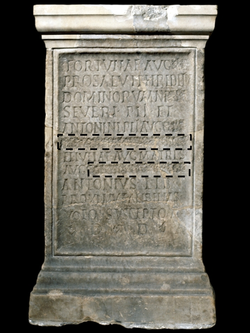
their names were expunged from all official records and inscriptions
and their statues and all images of them were destroyed.
This process [damnatio memoriae] was the most horrendous fate
a Roman could suffer, as it removed him from the memory of society.(1)
However, removing Geta from public consciousness was not a straightforward matter. Caracalla was obliged to give his brother a proper funeral and burial due to Geta’s popularity both with the Roman army and among substantial sections of Roman society. This explains why the names of Geta and Plautilla were included on the British Museum’s marble inscription, only to be scratched out later on.
Why am I mentioning all this? Because a modern-day form of damnatio memoriae is currently unfolding in British society. This is in relation to the disc jockey, children’s television presenter and media celebrity, Sir Jimmy Savile OBE, KCSG, LLD (1926-2011). When he died last year at the ripe old age of 84 he was hailed a loveable hero who had done much for charity. Now, however, revelations have come to light suggesting that he was, in the words of the police, a “predatory sex offender”.(2)
As a result, strenuous efforts are being made to expunge him from the public record.(3) Thus, the charity that bears his name is considering a rebrand. A plaque attached to his former home in Scarborough was vandalised and has since been removed. So too has the sign denoting “Savile’s View” in the same town. Meanwhile, in Leeds, his name has been deleted from a list of great achievers at the Civic Hall. A statue in Glasgow has been taken down in an act of officially sanctioned iconoclasm. The same fate has been dished out to the elaborate headstone marking Savile’s grave. This last-named act of damnatio memoriae is in some ways a pity given the unintended poignancy of the epitaph inscribed on the stone: “It Was Good While It Lasted”. It was almost as if Savile knew that he would one day have to atone for his evil deeds.
Atonement has, alas, come too late for those that suffered at the hands of Savile. To make matters worse, his considerable fame has been replaced by a burgeoning notoriety. This is reminiscent of the damnatio memoriae that befell Geta and his sister-in-law Plautilla. The marble inscription that once carried their name is a “highlight” of the British Museum precisely because of the dark deeds associated with them and the futile efforts made to delete them from history. In their case, damnatio memoriae has, in a perverse way, enhanced their posthumous status centuries after their grisly deaths. Let’s hope that the same will not be said of the late Jimmy Savile – an individual who has gone from saint to scoundrel in the space of just a few short months.
___
Notes
(1) “Marble inscription with damnatio memoriae of Geta, son of Septimius Severus” (Roman, AD 193-211, from Rome, Italy, height 81.5 cm, width 47.5 cm, British Museum, Townley Collection, GR 1805.7-3.210, http://www.britishmuseum.org/explore/highlights/highlight_objects/gr/m/marble_inscription.aspx).
(2) Martin Beckford, “Sir Jimmy Savile was a ‘predatory sex offender’, police say”, The Daily Telegraph, 09/10/2012, http://www.telegraph.co.uk/news/uknews/crime/9597158/Sir-Jimmy-Savile-was-a-predatory-sex-offender-police-say.html.
(3) “Jimmy Savile’s headstone removed from Scarborough cemetery” and “Sir Jimmy Savile Scarborough footpath sign removed”, BBC News, 12/10 & 08/10/2012, http://www.bbc.co.uk/news/uk-england-york-north-yorkshire-19893373 and www.bbc.co.uk/news/uk-england-york-north-yorkshire-19867893.






